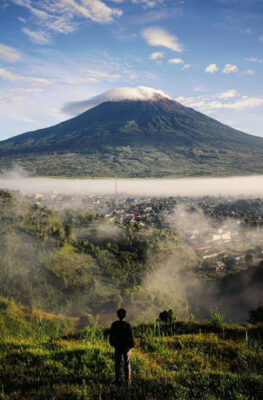Published on October 8, 2014
Minister of Tourism and Creative Eonomy, Mari Elka Pangestu, stated she is confident that the tourism and creative economy sectors will continue to show and maintain rapid growth in future, and will emerge as a new economic power of Indonesia. This is reflected from achievements made by the tourism and creative sectors in the past three years.
“When the world’s economy was uncertain and our exports grew weaker due to the decline of prices and demand of commodities, the two sectors have proven to remain resilient and even contributed significantly to our economy and created more employment” said Minister Mari at the Balairung Soesilo Sudarman Hall at the Tourism and Creative Economy Building in Jakarta, Monday, 6th October 2014.
Data show that the number of international tourists to Indonesia increased from 7 million in 2010 to 8.8 million in 2013. Seeing this continued growth, the target of 9.5 million tourists by the end of 2014 will optimistically be achieved.
The top 5 countries of origin of tourists from 2011 to 2014 were Singapore, Malaysia, Australia, the People’s Republic of China, and Japan. Receipts from international tourists has also increased from US$7.6 billion in 2010 to USid=”mce_marker”0 billion in 2013 (a growth rate of 10%) and is projected to be USid=”mce_marker”1billion or increasing 10.7% by the end of this year 2014.
While, domestic tourists movements have also increased from 234.4 million trips in 2010 to 248 million in 2013. The number is estimated to grow to 255 million in 2014 with total expenditure reaching IDR180 trillion.
These figures have shown that the contribution of the tourism sector towards the national economy continues to grow. This is truly significant especially when the economy faces global crisis as experienced last year.
When revenues from exports declined drastically due to uncertainties of the global economy and the fall of commodity prices, tourism remained unaffected and even experienced growth in its contribution to the national economy from 10% to 17% from total exports of products and services. Its position in foreign revenue contribution also rose from 5th to 4th place through foreign tourism rceipts of USD10billion.
ASEAN remains a promising market for Indonesia since the region recorded the highest growth rate compared to other areas. In 2013, the flow of tourists to ASEAN countries reached 92.7 million or increasing 12% compared to the previous year.
“This is a big opportunity, Indonesian tourism needs to take benefit from this to strengthen our national economy” added Minister Mari.
To prepare for global competition, there are a number of essential points from the Mid-Term Tourism Planning Programs that need to be addressed:
1.Increase the number of National Tourism Strategic Areas (KSPN) to 25 (including the existing 16) through improved and coordinated planning and implementation.
2.Promotions in primary international tourist markets (Singapore, Malaysia, Australia, People’s Republic of China), in secondary markets
(Japan, South Korea, the Philippines, Taiwan, USA, UK, France), and tertiary international markets (India, Netherland, Middle East, Germany, Russia); with efforts to raise the quality besides quantity of international tourists.
3.The 7 thematic and special interest tourism sectors remain, while implementation of action plans are to be undertaken more thoroughly.
4.Prioritize the domestic tourist segment especially in the 16 top domestic tourist markets (West Java, Central Java, East Java, Jakarta, North Sumatra, Yogyakarta, South Sulawesi, Bali, Banten, Lampung, South Sumatra, West Sumatra, Riau, East Nusa Tenggara, and Aceh).
It should further be noted that achievements made in the creative economy have also met and exceeded the targets of the Strategic Plan (Renstra). This is indicated from the growing number of people involved in its growth , to mention the creators of the movie “The Raid” and the emergence of renowned fashion designer Tex Savario. There is also a growing number of creative communities such as the Indonesia Photography Forum, Animation Forum, Film Forum, and more.
The Creative economy is also considered potential to emerge as a new economic power with limitless resources. The reason for this is that the main resources are the creative people themselves who constinuously develop their creativity under conducive conditions.
The Ministry of Tourism and Creative Economy has also facilitated the development of the creative economy by establishing a Focus Group Discussions (FGD) and continues to perfect the long and mid term plans of the Creative Economy, said Minister Mari Pangestu.






